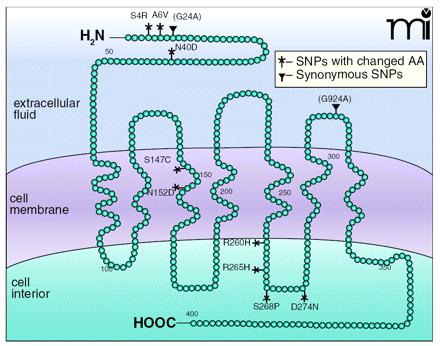
- Institution: Stanford Univ Med Ctr Lane Med Lib/Periodical Dept/Rm L109
- Sign In as Member / Individual
Stress Responsivity, Addiction, and a Functional Variant of the Human Mu-Opioid Receptor Gene

The seven-transmembrane domain G protein–coupled human μ-opioid receptor. Circles represent amino acids. The positions of naturally occurring genetic variants in the coding region, all of which are single nucleotide polymorphisms (SNPs) are indicated, including those that result in an amino acid change and those that do not (synonymous SNPs). The most common coding region variant is the A118G polymorphism, which encodes the substitution of asparagine to aspartic acid (Asn40Asp or N40D) in the extracellular N-terminal domain. This change abolishes one of five putative N-linked glycosylation sites, results in physiogenetic and pharmacogenetic alterations in physiological systems in which the μ-opioid receptor plays a role, and is associated with specific addictions, including alcohol and opioid. In vitro studies have also found alterations in receptor function for several other SNPs, particularly those in the third intracellular loop; however, these variants are rare, and therefore will not figure significantly in common disorders such as addictions. Figure reproduced from (5). ©2000, used with permission from Elsevier.


